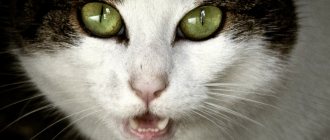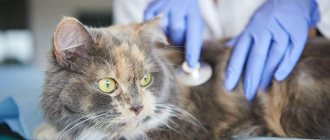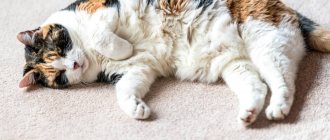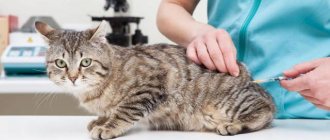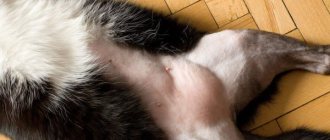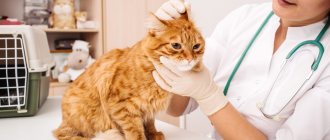Time has passed, and your pet has grown from a mischievous kitten into a kitty that requires attention, and she is in heat. For yard pets during heat, the process of having offspring is much more romantic than for purebred pets, who are deprived of the privilege of choosing an ally. They are forced to live according to the law of their bloodline, they have to be content with who they offered. Sometimes due to these circumstances false matings occur. It seems that a date with a cat has happened, but how can you determine that your favorite will finally bring the long-awaited offspring? In this article we will talk about the main signs of pregnancy in cats.
Signs of successful mating
The most successful period for mating is 3-5 days from the start of estrus. For the process to be successful, the cat must temporarily move in with the cat, and in the first few hours the animals may have misunderstandings and even fights. It is better to give the female time to calm down and get used to the new environment. It is best for the move to take place on the first day of estrus.
Moreover, the cat itself begins to flirt with the cat, provoking him to take active actions, then shows aggression, not letting him near her. Sometimes a cat covers a cat, several times, but the long-awaited success is not observed. In order to figure out whether full coverage has occurred or not, you need to know the signs of successful mating:
- After contact with the cat, the female begins to roll around on the floor.
- The mucous membranes of the genital organs swell and become brighter in color.
- The male completely loses interest in the cat, calmly moves away, and begins to lick himself with enthusiasm.
- If, nevertheless, the cat continues to pay attention to the female, he receives a sharp refusal.
- The cat may lose its appetite and become lethargic within 4 days.
If your cat has a fever and bleeding from the genitals, you should consult a veterinarian.
Feeding a pregnant cat
During the first four weeks of pregnancy, feed your cat kitten food or high-quality all-purpose food such as Orijen, Acana and Go! They contain everything necessary for the normal development of the fetus. Many cats during pregnancy and feeding kittens have a very uneven appetite for meat, try to encourage this by giving raw frozen beef or veal every day. But it is better to avoid treats and “pieces from the table”, as this can reduce the cat’s appetite, and, therefore, she will not receive the calcium, vitamins, proteins and other useful components of dry food she needs. Also, do not give your cat vitamin supplements - dry food contains everything it needs, and an excess of vitamins can negatively affect kittens. The exception is when the pregnant cat is weakened. Only a doctor can determine these exceptions! From the second half of pregnancy, the cat's need for nutrients increases, so it is worth increasing its diet by 50%. Offer your cat 2-3 times a week baby cottage cheese (and possibly more often), cheese or fermented baked milk. If desired, fermented milk can be given every day, but separated by feeding time with meat. For example, cottage cheese in the morning and meat in the evening, then calcium and iron will be absorbed. Keep an eye on your cat and avoid obesity. An obese cat can carry very large kittens, which in turn can lead to a difficult birth. But you shouldn’t underfeed either.
Early signs
Not every mating can result in pregnancy. In the early stages, it is quite difficult to find out whether a cat has managed to get pregnant, but you can try to figure it out based on the following signs:
- If after mating the female continues into estrus, then most likely the long-awaited process has not occurred.
- After pregnancy, a cat can be affectionate.
- The animal develops drowsiness, apathy, and decreased appetite. The previously active mischievous woman has turned into a lazy creature - this is how hormonal changes affect her.
- A sharp change in the behavior of the female may indicate hormonal changes in the body.
- In the early stages, a change in the color of the nipples occurs, which turn pinkish. There are times when changes in color do not occur in all nipples, but only in some.
Preparing for childbirth
As a rule, the cat copes with childbirth on its own, but you need to be prepared for any turn of events, so a complete birth kit includes:
necessary
- Childbirth box (this can be either a cardboard box or a reusable box with a removable lid and an opening at the level of the cat’s chest.)
- Absorbent diapers (diapers can be replaced with a regular pillowcase in which paper towels are laid in several layers to absorb moisture and odors, while the edges of the pillowcase should be hidden so that the kittens cannot get inside.) After giving birth, the diaper will need to be updated.
- Scissors (disinfected with alcohol or an alcohol-containing solution)
- Lots of clean towels
- Gamavit
additional
- Vaseline oil
- Soap solution
- Electric heating pad (to maintain nest temperature)
Place for birth
The cat should give birth at home, where everything is familiar to her and where she feels safe, since if the cat is nervous, she can artificially delay labor. Therefore, the birthing house should be located in a quiet, shaded, dry place where the cat will not be disturbed. The room must be clean, dry, well ventilated and warm. Small kittens are very sensitive to humidity and temperature; they die from dampness and cold. For the first week of life, the temperature in the nest should be approximately 29 degrees, then drops by 3 degrees weekly to 21. To maintain this temperature, a heating pad is placed at the bottom of the box, or infrared lamps are hung above the box. At the same time, there should always be an unheated place in the box so that if the cat gets hot, she can move there, otherwise the cat will often leave the kittens.
In addition, during the birth, it is worth stocking up on another small box with a heating pad or bottles of warm water in case the cat for some reason cannot take care of the kitten and needs to be warmed up.
For the “nest” itself, a box with disposable baby diapers (sold in a pharmacy) is suitable, on top of which it is better to put cotton or linen cloth. The edges must be tucked in so that the kitten cannot crawl under them and get entangled. Under no circumstances should you use soft napkins or torn paper, as they may stick to the kitten’s body and the mother will refuse to lick it. Such a kitten is in danger of choking in the amniotic sac. Place the box in a warm, protected location, preferably the location where the cat's pregnancy primarily occurs. Make sure everything is ready at least two weeks before the birth.
Late signs of pregnancy detection
More precisely, it is possible to say whether conception has occurred in about three weeks. The following symptoms will help you understand:
- You can use palpation to determine the presence of embryos in the tummy. Pressure must be done very carefully so as not to harm the babies. Too harsh an examination can cause a miscarriage.
- The mammary glands and nipples become swollen and acquire a brighter color.
- There is a sharp increase in appetite, and variability in the perception of foods may occur. Previously consumed food may be rejected, and interest in previously unloved food may appear.
- At 3-5 weeks, the tummy becomes rounded.
- When they reach 6 weeks, the kittens can be palpated.
- At 7-8 weeks, it is possible to notice the movement of the babies, feel the heartbeat, and identify the head and body.
Cat genitals
The female genital organs are usually divided into internal and external (Fig. 1).
Rice. 1. Female genital organs, top view: 1 - accessory ovarian ligaments; 2 - ovaries; 3 - own ovarian ligaments; 4 - fallopian tubes; 5 - uterine horns; 6 - body of the uterus; 7—cervix; 8 - bladder; 9 - vagina; 10 - urethral opening; 11 - vestibule of the vagina; 12 - clitoris; 13 - labia
Internal genital organs. These include the ovaries, fallopian tubes, uterus and vagina. The ovaries (Ovaria, Oophoron) are the primary paired sex gland that performs reproductive and hormonal functions. The ovaries are ovoid in shape, somewhat flattened laterally, reaching a diameter of approximately 1 cm. During heat, the luteal phase of the sexual cycle and during pregnancy, their shape can be grape-shaped. The ovaries are located in the abdominal cavity behind and below the kidneys in the open ovarian bursa. The wall of the latter is formed by the mesentery of the fallopian tubes and is translucent (does not contain fatty deposits). Its lower edge does not form adhesions with surrounding tissues and is therefore easily removed from the surface of the ovary. Using its own ligament, the ovary is connected to the apex of the corresponding uterine horn, and is attached to the lumbar vertebrae by means of an accessory (suspensory) ligament. The accessory ovarian ligaments in cats are quite long and elastic, contain blood vessels, are practically devoid of fat and generally provide good operational access to the ovaries. Externally, the ovary is covered with a single-layer cubic epithelium, under which there is a well-developed fibrous (albuginine) membrane. The ovarian parenchyma is represented by the medulla and cortex. The medulla consists of connective tissue, blood vessels and nerves and is localized inside the cortex. The connective tissue basis of the cortex contains the follicular apparatus of the ovary (primary, secondary and tertiary follicles) and the corpus luteum (Fig. 2).
Rice. 2. Ovary, sagittal section: 1 - integumentary epithelium; 2…4 - follicles: primary, secondary and tertiary, respectively; 5 — atresia of the follicle; 6 - ovulated follicle; 7—corpus luteum
Primary follicles, or primordial, resting, are a 1st order oocyte surrounded by a single layer of follicular cells. Secondary follicles, or growing ones, are first-order oocytes surrounded by two or more layers of follicular cells. At this stage of folliculogenesis, the egg actively grows and becomes covered with a transparent membrane. Tertiary follicles, or vesicular, cavity, graafian, contain a micro- or macroscopic cavity filled with follicular fluid. Their wall is lined from the inside with multilayered follicular epithelium, and on the outside - by the inner and outer layers of the connective tissue membrane (teca interna et externa). The cells of the follicular epithelium form an egg-bearing tubercle, in the center of which the 1st order oocyte is located. Tertiary follicles produce estrogenic hormones. The hormonal activity of graafian follicles depends on the degree of their maturity. The most endocrine-active ones are preovulatory follicles that have entered the final stage of their development. Their number can range from 1 to 8 or more. Shortly before ovulation they reach 2...3.5 mm in diameter. The fate of mature follicles can be different and depends on the presence or absence of sexual intercourse. When mating with a cat, the follicles ovulate (open and release an egg along with the flow of follicular fluid) and transform into the corpus luteum. In the absence of sexual intercourse, preovulatory follicles do not ovulate and after the end of sexual heat they become atretic (dissolve).
The corpus luteum is an endocrine gland of temporary secretion. Cells of the corpus luteum (luteocytes) produce progesterone, a hormone necessary to maintain pregnancy. There are corpora lutea of the reproductive cycle and pregnancy. In cats, the corpus luteum of the reproductive cycle is formed after sterile intercourse or after injection of drugs with LH (lutropin) or LH-releasing activity into females during the period of estrus. In structure and hormonal activity, the corpus luteum of the reproductive cycle corresponds to the corpus luteum of pregnancy and differs from the latter only in that it functions for a shorter period of time: on average 42 days, while the corpus luteum of pregnancy is 63...65 days. The fallopian tubes (Tuba uterina, Salpinx) , or oviducts, fallopian tubes, are a paired organ in the form of a convoluted tube extending from the apical part of each horn of the uterus. The fallopian tubes are located in their own mesentery, formed by the internal layer of the broad uterine ligament. Their opposite end opens into the cavity of the ovarian bursa; the wall consists of mucous, muscular and serous membranes. The mucous membrane is folded, its epithelium is single-layer cylindrical and is represented by secretory and ciliated cells. Sperm mature in the fallopian tubes (capacitation), the egg is fertilized and the embryo develops to the stage of a 16-cell blastomere. Germ cells and embryos are transported to the uterus due to vibrations of the cilia of epithelial cells and contraction of smooth muscle fibers of the organ wall. The contractile activity of the muscular lining of the fallopian tubes is stimulated by estrogens and suppressed by progesterone. The uterus (Uterus, Histera, Metra) in cats consists of a cervix, body and two horns. The cervix and body of the uterus are short, the horns are long and serve as a receptacle for the fruit, diverging at an acute angle, giving the uterus the shape of a slingshot. The size of the uterine horns in cats depends on the age and physiological state of the body (stage of the reproductive cycle, stage of pregnancy). For example, during the period of anestrus, the uterine horns are straight, reaching a length of 7.8 cm, a diameter of 0.3...0.4 cm; during the period of sexual heat they become longer, more convoluted and increase in diameter up to 0.5...0.7 cm. The wall of the uterus is built of three membranes: the outer - serous (perimetry), the middle - muscular (myometrium) and the inner - mucous (endometrium) . The muscular layer is represented by longitudinal and circular layers, between which there is a layer rich in blood vessels and nerves. The contractile activity of the body myometrium and uterine horns is stimulated by estrogens and suppressed by progesterone. The structure of the mucous membrane of the body and the horns of the uterus is quite complex. It is covered with a single-layer columnar epithelium; in its thickness there are numerous tubular glands, the ducts of which open into the uterine cavity. These glands produce the so-called royal jelly, which is necessary to nourish the embryo. The endometrium, like the myometrium, serves as a target tissue for sex hormones. Estrogens enhance the vascularization of the endometrium and stimulate the growth of endometrial glands. Progesterone causes branching of the tubular glands and stimulates the production of royal jelly. During pregnancy in cats, as well as in other placental animals, a placenta is formed from the mucous membrane of the uterus and the choroid of the fetus, which in its macroscopic structure belongs to the zonal (zonal) type, and in its microscopic structure - to the endotheliochorionic type. During childbirth, only the baby part of the placenta falls off. The cervix (Cervix uteri) is short, without clear boundaries with the body of the uterus and vagina; has a narrow channel, a thick wall with a well-developed muscle layer. The cervix acts as a sphincter of the uterus. Full opening of its canal is noted during childbirth, partial opening - during periods of estrus, sexual heat and postpartum. The opening of the cervix during childbirth is stimulated by estrogens and relaxin; during estrus - only estrogenic hormones. The epithelium of the mucous membrane of the cervix is single-layered, cylindrical and is represented mainly by secretory cells that produce a mucous secretion with bactericidal and bacteriostatic properties. Unlike many other animals, the mucous membrane of the cervix in cats contains tubular glands. The uterus is located in the abdominal cavity and is supported by wide and round uterine ligaments. The broad ligaments of the uterus are double layers of peritoneum that extend from the lesser curvature of the horns, the lateral surface of the body, the cervix and the cranial part of the vagina to the lateral walls of the pelvis. The round ligaments of the uterus in the form of cords extend from the top of the uterine horns and are directed to the internal opening of the inguinal canal. The vagina (Vagina) , or vagina, is a thin-walled elastic tube extending from the cervix to the opening of the urethra (urethra). It is located in the pelvic cavity and serves as an organ of copulation and the birth canal. The inside of the vaginal wall is lined with a mucous membrane, devoid of glands and covered with stratified squamous epithelium. Under the influence of estrogens during the period of proestrus and especially estrus (sexual heat), the number of layers of epithelial cells increases, the surface cells become keratinized, lose their nucleus, and keratin accumulates in their cytoplasm. The second membrane of the vagina is represented by two layers of muscles: longitudinal and circular (transverse). The cranial part of the vaginal tube is externally covered with a serous (peritoneal) membrane, the rest is covered with loose connective tissue, which, together with pararectal tissue, ensures fixation of the vagina and rectum in the pelvic cavity. External genitalia. These include the vestibule of the vagina, labia and clitoris. The vestibule of the vagina (Vestibulum vaginae) serves as the urogenital canal. Its mucous membrane is covered with stratified squamous epithelium and accordingly performs a protective function. In the thickness of the mucous membrane there are paired vestibular glands that produce a mucin-like secretion during the period of sexual heat. The muscular layer is well developed. The boundary between the vagina and its vestibule is the opening of the urethra. The hymen (Hymen) in cats is poorly developed or absent. The vestibule of the vagina passes caudally into the genital fissure (Rima pudendi) , bounded by the labia vulvae , or vulva, genital loop. The upper corner of the vulva is rounded, the lower is pointed. In the lower corner of the genital slit there is the clitoris (Clitoris) , a homologue of the penis. The clitoris consists of fibrous, adipose and erectile tissues, is rich in sensory nerve endings, and does not contain the genital bone. The most important functions of the female reproductive organs are given below.
Blood supply and innervation of the cat's genital organs. The female genital organs are supplied with blood by vessels arising from the ovarian artery, or ovarian artery (Arteria ovarica), and branches of the internal pudendal artery (A. pudenda interna). The ovarian artery branches directly from the aorta, behind the renal artery and is divided into two branches - tubal (Ramus tubarius) and uterine (R. uterinus), which supply blood to the ovaries, fallopian tubes and the cranial part of the uterine horns.
The internal pudendal artery originates from the internal iliac artery (A. iliaca interna), which, in turn, is formed during the division of the abdominal aorta. Two main branches of the internal pudendal artery take part in the blood supply to the genital organs: the vaginal artery (A. vaginalis) and the ventral perineal artery (A. perinealis ventralis). The vaginal artery supplies blood to the vaginal wall and at the level of the cervix passes into the uterine artery (A. uterina), which vascularizes the walls of the cervix, body and 2/3 of the uterine horns. The branches of the ventral perineal artery supply blood to the external genitalia and perineal tissue. Ovarian veins (Venae ovaricae) serve as the main trunk through which venous blood is drained from the genital organs. In this case, the right ovarian vein (V. ovarica dextra) flows into the posterior vena cava (V. cava caudalis), the left ovarian vein (V. ovarica sinistra) into the left renal vein (V. renalis). The lymphatic system of the genital organs is well developed. Lymph flowing from the genitals is collected in regional lymph nodes - pelvic, sacral and inguinal. Lymph nodes perform filtration-barrier and immune functions. The reproductive organs of cats are innervated by sympathetic and parasympathetic fibers. Sympathetic fibers arise from the pelvic plexus (Plexus pelvinus), parasympathetic fibers from the sacral nerves (Nervi sacrales). The external genitalia and vagina are also well supplied with sensory nerve fibers.
Related:
- Ectopic (ectopic) pregnancy in cats
- Abortion in cats
What changes occur before childbirth?
It is very important for the owner to know the due date, because it is unknown how this process will go, and it may be necessary to provide assistance to the pet. You can find out when this period is approaching using the following signs:
- About 3 days before the onset of birth, the cat begins to look for a secluded corner, she looks for a suitable place, and begins to build a nest. To prevent this process from happening on your bed, it is best to prepare for it in advance. You can offer her a box covered with a warm cloth and a sheet on top.
- The cat's nipples sharply increase in size, from which colostrum is secreted. Mucus discharge is observed from the genitals.
- The temperature drops sharply by about 1 degree and can reach 37 degrees.
- 10 hours before the birth of the offspring, the pet hides in its nest. There is no need to disturb her; you can help at this stage by providing fresh water.
How to understand that labor is approaching
Cats look for a secluded place to give birth, so it is advisable to prepare a cozy nest for your pet in advance so that you don’t have to take the kittens out from under the sofa or bathtub. A box with high sides or the bottom drawer of a dresser will do. The bottom should be lined with disposable diapers or a clean old cloth (you will have to throw it away later). You can determine that labor is approaching by the following signs:
- the cat becomes restless and follows the owner;
- looks for a secluded place, begins to build a nest;
- refuses food and water;
- often licks genitals;
- Colostrum appears on the nipples.
Right before giving birth, the cat lies down on its side in the chosen location. She begins to breathe frequently through her mouth, tremble, and may meow. If the pregnancy proceeded normally, the cat will be able to give birth on its own. It’s better to leave her alone and watch, talk in a calm voice, caress her. Typically, labor lasts from 7 hours to 24 hours.
When to contact a veterinarian
In most cases, the cat does not require assistance to give birth. But there are situations in which it is better to contact a veterinarian:
- if more than 72 days have passed and labor has not occurred;
- contractions continue for a long time, but the kitten does not appear;
- the water broke more than 30 minutes ago, but the kitten was not born;
- severe bleeding appeared;
- the cat gives birth for the first time, the owner has no experience, and he is afraid.
After giving birth, you should contact a veterinarian if the animal has a fever, vomiting and intestinal upset. The development of complications may also be indicated by a lack of appetite and spotting that lasts longer than 10 days.
Diagnostic definition of pregnancy
Some owners are interested in the question of whether it is possible to determine whether conception has occurred in an animal using a human test. Veterinarians give a clear answer that the test is not suitable for mustaches. It is possible to determine whether the female managed to become pregnant using ultrasound only after the first 2 weeks. After 5 weeks, the veterinarian will perform a palpation test and tell you how many kittens she will give you.
You can find out whether your pet managed to get pregnant using a clinical test for relaxin. This test can provide reliable information only 3 weeks after the expected day of the onset of an interesting situation; it requires blood plasma. The result will be ready in 10 minutes. You can determine whether your attempt to get pregnant was successful using an x-ray 5 weeks after mating.
The main causes of false pregnancy
There can be many such factors:
- Hereditary predisposition.
- Ineffective mating.
- Stress.
- The presence of an already pregnant animal nearby.
- Disorders of the reproductive organs (hormonal imbalances), etc.
For these reasons, various processes (physiological and psychological) are launched in the body. The animal begins to prepare to bear a non-existent fetus.
How can the diagnosis be confirmed?
An experienced veterinarian is able to accurately analyze the situation. If necessary, an ultrasound examination of the abdominal organs is prescribed. The diagnosis is made based on the results of the examination, external examination and medical history.
When should you contact a veterinarian immediately?
At this time, the cat especially needs a caring attitude from the owner. If she exhibits the following signs, you should call your veterinarian immediately:
- The pet refuses to eat for more than 2 days.
- Fever, above 39 degrees.
- The cat drinks a large amount of fluid and at the same time breathes heavily.
- The female licks herself very often, and dark discharge is observed from the loop. If the discharge is red, you should urgently take it to the clinic.
Attentive attitude to the animal after mating will help to easily determine the presence of pregnancy. Only a specialist will give more accurate information; he will also recommend methods of caring for the cat, tell you how to properly help her prepare for a difficult moment, and give recommendations for helping the animal during childbirth.
How to care for a cat during pregnancy
Proper care of your pet during pregnancy will help to avoid complications, ensure her good health and the birth of healthy kittens. There are several rules that owners must follow, they are especially important from 4 weeks:
- do not play outdoor games, protect from jumping;
- limit communication with children;
- do not pick up unless necessary;
- do not press on the stomach;
- try not to disturb if she wants to lie down;
- provide a cozy place to relax;
- change the filler more often and keep the tray clean;
- protect from stress: large crowds of people, swimming, moving.
The expectant mother's nutrition should be complete. In the first half of pregnancy it usually does not change. In the second half, you will need to increase the amount of protein and calcium in your food. Feed 4-5 times a day in small portions. The expectant mother should receive vitamins, minerals, especially calcium. Therefore, it is recommended to switch her to special dry food, which can be given after birth.
If the cat ate natural food, it cannot be switched to dry food. It is necessary to increase the amount of lean meat, cottage cheese and fermented milk products in the diet. Vitamin and mineral supplements should be given as recommended by your veterinarian.
Abdominal changes during pregnancy
In the first couple of weeks after fertilization, it is difficult to determine pregnancy from the cat’s belly. But at the end of the 20th day, the animal owner may notice a change in the color of the nipples. In a non-pregnant state, the nipples are the same color as the skin on the cat's tummy. It is noteworthy that in a cat who has given birth previously, the pigmentation may not be so pronounced.
The belly begins to grow rapidly as the kittens grow inside the womb. The size of a pregnant woman's abdomen depends on the number of fetuses and their size. During a low-fertility pregnancy, the belly can be practically torn off until the last weeks.
About 7 days before the start of the birth process , the cat’s belly begins to sag greatly, taking on a peculiar pear-shaped shape. This is due to the fact that the kittens are already preparing to come out and are localized in the lower abdomen. The nipples on the stomach droop, the first milk begins to ooze.
How long is the gestation period in cats?
The first thing to remember is the time from which pregnancy begins - from the moment of mating and fertilization and at the end of this period with childbirth. The average gestation period for kittens ranges from 62 to 68 days. In cases of premature birth, kittens appear dead.
But this does not apply to all cat breeds; there have been cases where Siamese representatives gave birth to offspring on the 71st day of pregnancy, and the kittens were alive and completely healthy.
Cat behavior just before labor begins
If the initial period of pregnancy is missed due to the owner’s carelessness, you should know how to determine the onset of labor in a cat.
Most cats do not require assistance with their kittens.
A few days before lambing, the animal may completely stop eating, and its behavior becomes quite nervous. During this period, you can notice how the stomach drops, water flows out, the shade of which is gray with a red admixture. Labor can last about a day.
Most cats do not require assistance when giving birth to kittens; they are able to gnaw the umbilical cord themselves using their teeth. However, not all animals are the same, which is why some cats ask their owners for help.
Some cats will still need help, and during pregnancy you should pay more careful attention to your pet
During the postpartum period, the animal should be helped to recover by showing care. It is worth treating the mammary glands to prevent bacteria from entering.




